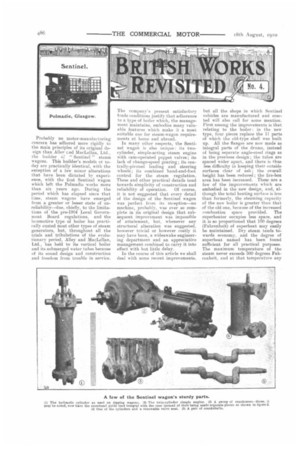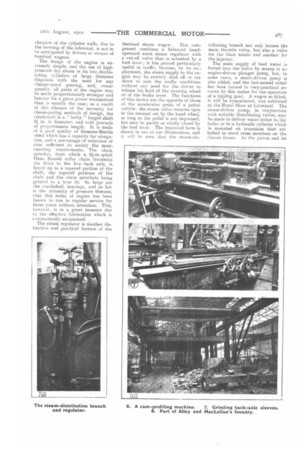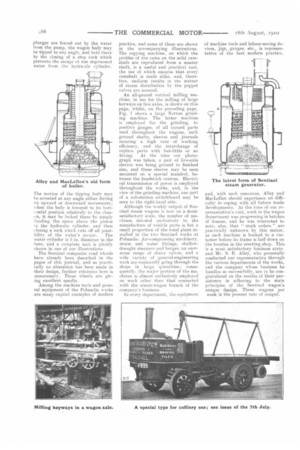Probably no motor-manufacturing concern has adhered niece rigidly to the
Page 4

Page 5

Page 6

If you've noticed an error in this article please click here to report it so we can fix it.
main principles of its original design than Alley. t..nd MacLellan, Ltd.,
the builder " Sentinel " steam wagons. This builder's models ot today are practically identical, with the exception of a few minor alterations that have been dictated by experience, with the first Sentinel wagon which left the Polmadie works more than six years ago. During the period which has elapsed since that time, steam wagons have emerged from a greater or leaser state of unreliability—due, chiefly, to the limitations of the pre-1904 Local Government Board regulations, and the locomotive type of boiler has practically ousted most other types of steam generators, but, throughout all the trials and tribulations of the evolutionary period, Alley and MacLellan, Ltd., has held to its vertical boiler and its submerged water tubes because of its sound design and construction and freedom from trouble in service. The company's present satisfactory trade conditions justify that adherence to a type of boiler which, the management maintains, embodies many valuable features which make it a most suitable one for steam-wagon requirements at home and abroad.
In many other respects, the Sentinel wagon is also unique: its twocylinder, simple-acting steam engine with cam-operated poppet valves; its lack of change-speed gearing; its centrally-pivoted leading and steering wheels; its combined hand-and-foot control for the steam regulation. These and other practical details tend towards simplicity of construction and
reliability of operation. Of course, it is not suggested that every detail of the design of the Sentinel wagon was perfect from its inception—no machine, probably, was ever so complete in its original design that subsequent improvement was impossible of attainment, but, whenever any structural alteration was suggested, however trivial or however costly it may have been, a wideawake engineering department and an appreciative management combined to carry it into effect with but little delay.
In the course of this article we shall deal with some recent improvements, but all the shops in which Sentinel vehicles are manufactured and erected will also call for some mention. First among the improvements is that relating to the boiler : in the new type, four pieces replace the 11 parts of which the old-type shell was built up. All the flanges are now made as integral parts of the drums, instead of being separate angle-steel rings as in the previous design ; the tubes are spaced wider apart, and there is thus less difficulty in keeping their outside surfaces clear of ash ; the overall height has been reduced ; the fire-box area has been increased. These are a few of the improvements which are embodied in the new design, and, although the total heating surface is less than formerly, the steaming capacity of the new boiler is greater than that of the old one, because of the increased combustion space provided. The superheater occupies less space, and it is so proportioned that 100 degrees (Fahrenheit) of superheat may easily be maintained. Dry steam tends to.wards economy, and the degree of superheat named has been found sufficient for all practical purposes. The maximum temperature of the steam never exceeds 500 degrees Fahrenheit, and at that temperature any abrasion of the cylinder walls, due to the burning of the lubricant, is not to be anticipated by drivers or owners of Sentinel wagons. The design of the engine is extremely simple, and the use of highpressure dry steam in its two doubleacting cylinders of large diameter dispenses with the need for any change-speed gearing, and, consequently, all parts of the engine may be made proportionately stronger and heavier for a given power transmitted than is usually the case; as a result of this absence of the necessity for cheese-paring methods of design, the crankshaft is a " hefty " forged shaft 31, in. in diameter, and with journals of proportionate length. It is made of a good quality of Siemens-Martin steel which has a capacity for elongation, and a percentage of reduction of area sufficient to satisfy the mostexacting requirements. The chain sprocket, from which a 2i-in.-pitch Hans Renold roller chain transmits the drive to the live back axle, is keyed on to a tapered portion of the shaft, the tapered portions of the shaft and the chain sprockets being ground to a true fit. So large are the crankshaft bearings, and so low is the intensity of pressure thereon, that. this make of engine has been known to run in regular service for three years without attention. This, however, is in agreat measure due to the effective lubrication which is automatically maintained.
The steam regulator is another distinctive and practical feature of the Sentinel steam wagon. This com ponent combines a balanced handoperated main steam regulator with a cut-off valve that is actuated by a foot lever ; it has proved particularly useful in traffic, because, by its employment, the steam supply to the engine may be entirely shut off or cut down to suit the traffic conditions without any need for the driver to release his hold of the steering wheel or of the brake lever. The functions of this device are the opposite of those of the accelerator pedal of a petrol vehicle: the steam valve remains open to the amount set by the hand wheel, so long as the pedal is not depressed, but may be partly or wholly closed by the foot lever. The improved form is shown in one of our illustrations, and it will he seen that the steam-dis
tributing branch not only houses the main throttle valve, but also a valve for the blast nozzle and another for the injector. The main supply of feed water is forced into the holler by means oi an engine-driven plunger pump, but, in some eases, a steam-driven pump is also added, and the last-named detail has been turned to very-practical account by this maker for the operation of a tipping gear. A wagon so fitted, it will be remembered, was exhibited at the Royal Show at Liverpool. The steam-driven pump, in conjunction with suitable distributing valves, may be made to deliver water either to the boiler or to a, hydraulic cylinder which is mounted on trunnions that are bolted to stout cross members on the chassis frame. As the piston and its
plunger are forced out by the water from the pump, the wagon body may be tipped to any angle, and held there by the dosing of a stop cock which, prevents the escape of the imprisoned water from the hydratlic cylinder.
The motion of the tipping body may he arrested at any angle either during its upward or downward movements; when the body is lowered to its horieontal position relatively to the vitaesisi it may be locked there by simply flooding the space above the piston in the hydraulic cylinder, and then closing a cock which cuts off all possi
bility of the water's escape. The water cylinder is :5 in. diameter in the bore,and a complete unit is plainly shown in one of our illustrations.
The Sentinel composite road wheels have already been described in the pages of this journal, and as practically no alteration has been made in their design, further reference here is unnecessary. These wheels are giving excellent results. Among the machine tools and gener ral equipment of the Polmadie works are many capital examples of modern practice, and some of these are shown in the accompanying illustrations. The copying machine, on which the profiles of the cams on the solid camshaft are reproduced from a master shaft, is a useful and practical tool, the use of which ensures that every camshaft is made alike, and, therefore, uniform results in the matter of steam distribution by the poppet valves are assured.
An all-geared vertical milling machine, in use for the milling of large keyways on live axles, is shown on this page, whilst, on the preceding page, Fig. 7 shows a large Norton grinding machine. The latter machine is employed for the grinding, to positive guages, of all turned parts used throughout the wagons, such ground shafts, sleeves and journals insuring a high rate of working efficiency, and the interchange of replace parts with but-little or no fitting. At the time our photograph was taken, a pair of live-axle sleeves was being ground to finished size, and these sleeves may be seen mounted on a special mandrel, between the headstock centres. Electrical transmission of power is employed throughout the works, and, in the view of the grinding machine, one part of a sub-station switchboard may be seen to the right-hand side.
Although the weekly output of Sentinel steam wagons is now on a mostsatisfactory scale, the number of. machines devoted exclusively to the manufacture of vehicle parts is but a small proportion of the total plant installed in the two Sentinel works at Polinadie. Air-compressing machinery, steam and water fittings, shallowdraught steamers and barges, an enormous range of sluice valves, and a wide variety of general-engineering work are constantly going through the shops in large quantities ; consequently, the major portion of the mac-hines is almost exclusively employed on work other than that connected with the steam-wagon branch of the company's business.
In every department, the equipment of machine tools and labour-saving devices, jigs, gauges, etc., is representative of the best modern practice, and, with such resources, Alley and MacLellan should experience no difficulty in coping with all future trade developments. At the time of our representative's visit, work in the wagon department was progressing in batches. of dozens, and be was interested to note, also, that " stock orders " are practically unknown by this maker, as each machine is booked to a customer before its frame is laid down on the trestles in the erecting shop. This is a most satisfactory business state, and Mr. S. Fe Alley, who personally conducted our representative through the various departments of the works, and the company whose business he handles so successfully, are to be congratulated on the results .of their persistence in adhering to the main principles of the Sentinel wagon's unique design. Three wagons per week is the present rate of output.
























